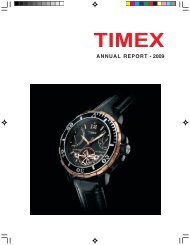Annual Report-FY 2012-13 - Timex Group India
Annual Report-FY 2012-13 - Timex Group India
Annual Report-FY 2012-13 - Timex Group India
Create successful ePaper yourself
Turn your PDF publications into a flip-book with our unique Google optimized e-Paper software.
Net realisble value is the estimated selling price in the ordinary course of business, less the estimated costs ofcompletion and the estimated costs necessary to make the sale.Finished goods held for the purpose of demonstration are amortised over a period of three years after deductingestimated residual value.h. Employee benefitsThe Company’s obligations towards various employee benefits have been recognised as follows:Short term employee benefitsAll employee benefits payable/available within twelve months of rendering the service are classified as short-termemployee benefits. Benefits such as salaries, wages and bonus etc., are recognised in the Statement of Profit andLoss in the period in which the employee renders the related service.Post employment benefitsIn respect of defined contribution plan in the form of Superannuation, the Trustees of the Scheme have entrustedthe administration of the Scheme to the Life Insurance Corporation of <strong>India</strong> (LIC). <strong>Annual</strong> contribution to the LICis recognised as an expense in the Statement of Profit and Loss.Charge for the year in respect of unfunded defined benefit plan in the form of gratuity has been ascertained basedon actuarial valuation carried out by an independent actuary as at the year end using the Projected Unit CreditMethod, which recognises each period of service as giving rise to additional unit of employee benefit entitlementand measures each unit separately to build up the final obligation. The obligation is measured at the present valueof the estimated future cash flows. The discount rate used for determining the present value of the obligation underdefined benefit plans is based on the market yields on Government securities as at the valuation date having maturityperiods approximating to the terms of related obligations. Actuarial gains and losses are recognised immediately inthe Statement of Profit and Loss.Provident Fund (PF): The Company deposits certain portion of the Provident Fund contribution with the RegionalProvident Fund Commissioner and will have no obligation to pay further amounts. Accordingly, this plan isconsidered as a defined contribution plan.For the remaining portion of Provident Fund, the Company contributes to the PF Trust which is administered bytrustees of an independently constituted Trust recognised by the Income-tax Act, 1961. Contributions, includingshortfall, if any, to the Trust are charged to the Statement of Profit and Loss on an accrual basis. As the providentfund scheme has a guaranteed return linked with that under Employee Provident Fund Scheme, 1952, the same hasbeen considered as a defined benefit plan. The present value of obligation has been determined based on actuarialvaluation done by independent actuary using the Projected Accrued Benefit Method. Under this method, the DefinedBenefit Obligation is calculated based on deterministic approach in respect of all accrued and accumulated providentfund contributions as at the valuation date. The cost of interest rate guarantee, if any, in respect of future providentfund contributions is not taken into consideration. This approach determines the present value of the interest rateguarantee under three interest rate scenarios: base case scenario, rising interest rate scenario and falling interest ratescenario. The Defined Benefit Obligation of the interest rate guarantee is set equal to the average of the present valuesdetermined under these scenarios in respect of accumulated provident fund contributions as at the valuation date.Gains or losses on the curtailment or settlement of any defined benefit plan are recognised when the curtailmentor settlement occurs.Other long term benefitsCompensated absences are in the nature of other long term employee benefits. Cost of long term benefit by wayof accumulating compensated absences that are expected to be availed after a period of 12 months from the yearend are recognised when the employees render the service that increases their entitlement to future compensatedabsences. The liability in respect of compensated absences is provided on the basis of an actuarial valuation doneby an independent actuary at the year end. Actuarial gains and losses are recognized immediately in the Statementof Profit and Loss.i. Revenue recognitionRevenue from sale of goods is recognised on delivery of goods to the buyer which coincides with transfer of allsignificant risks and rewards of ownership. The amount recognised as sale is inclusive of excise duty and excludessales tax and trade and quantity discounts.Revenue from services is recognised on rendering of services to customers on accrual basis.Interest income is recognised on a time proportion basis considering the rate of interest and amount invested.33





